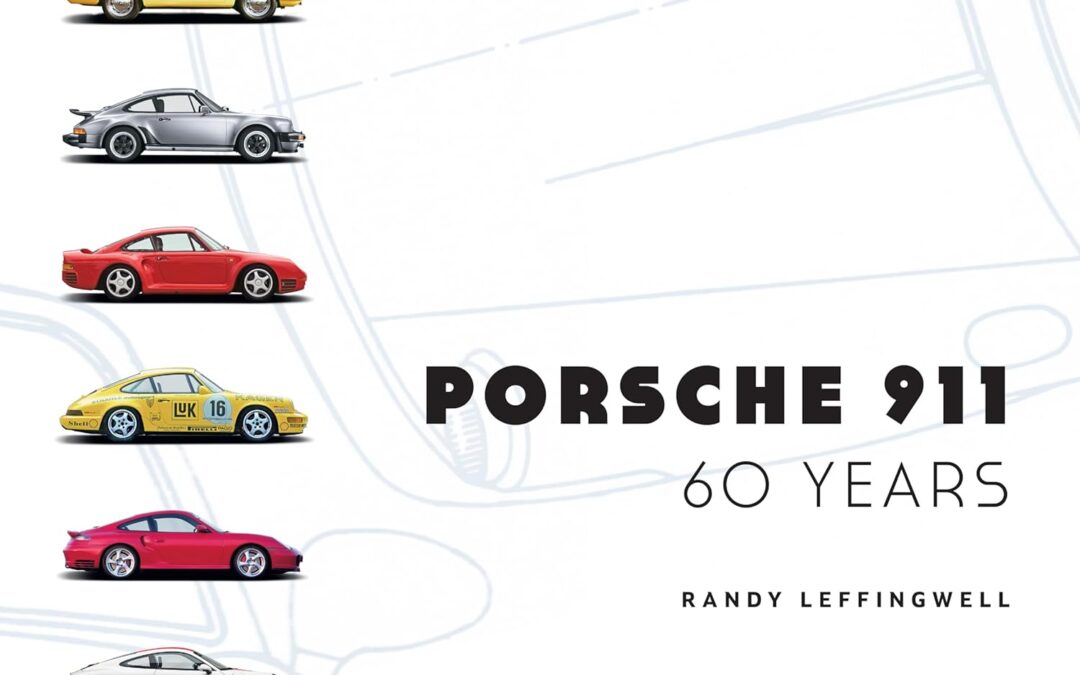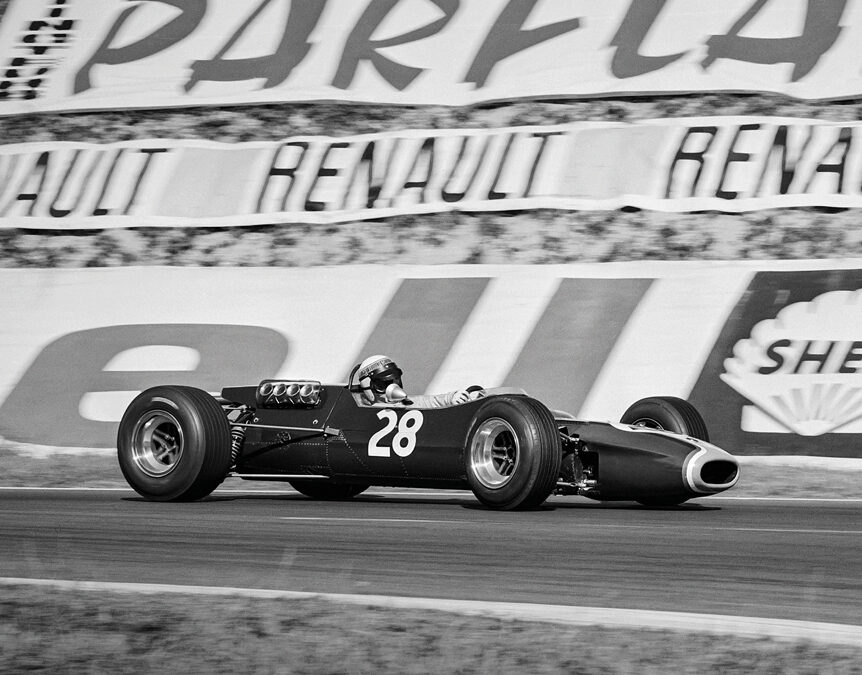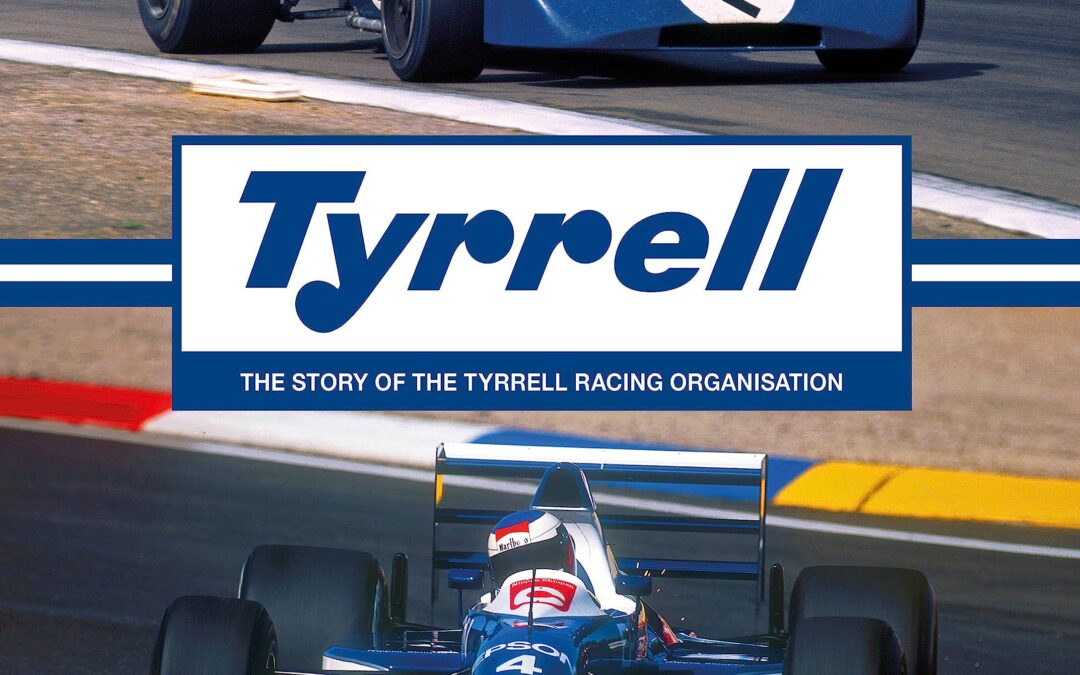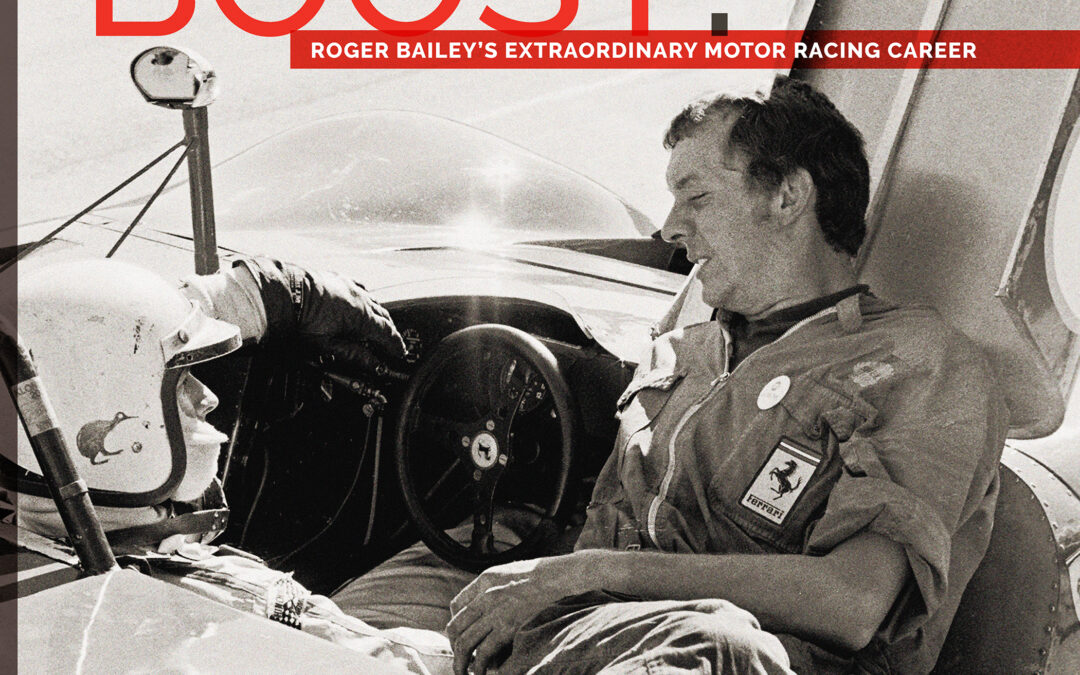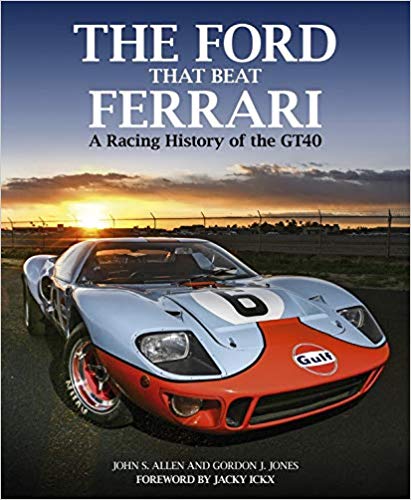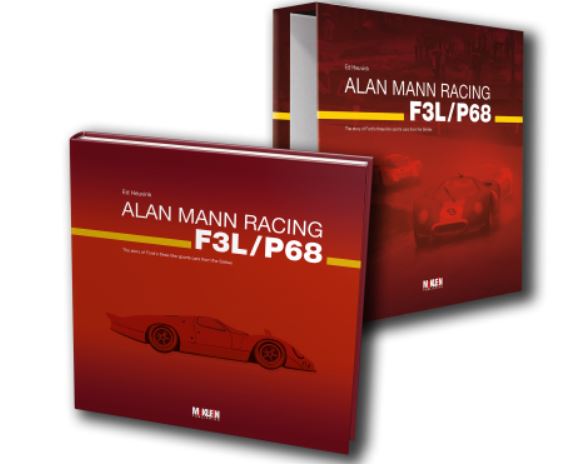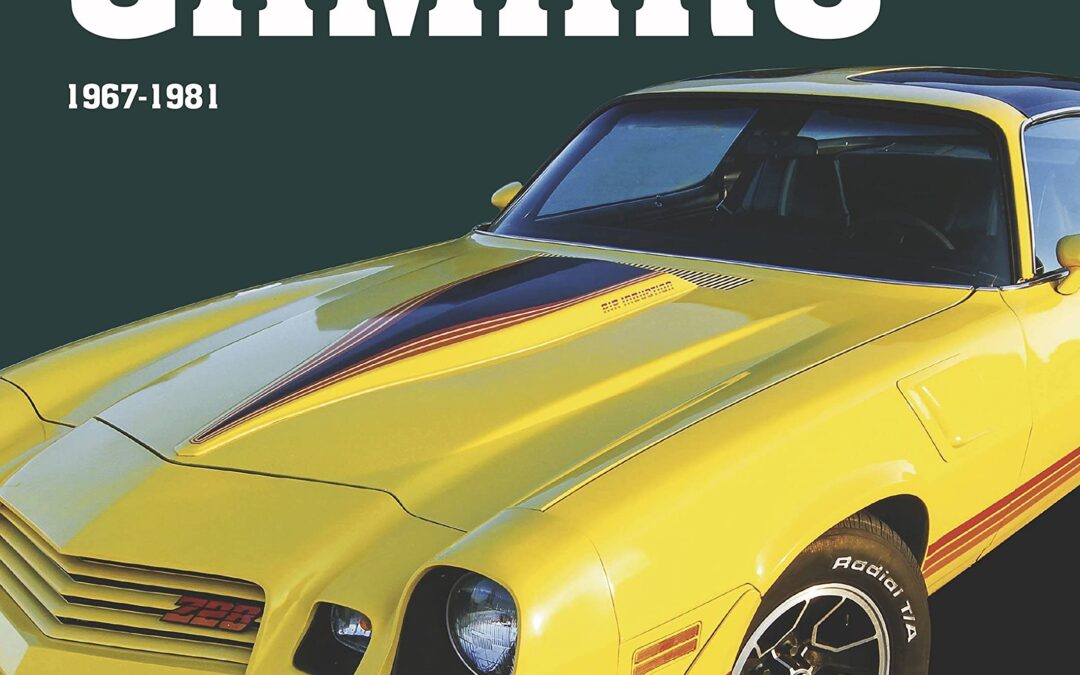
Chevrolet was Number One in the sales race. If you needed a car, chances are Chevrolet made it. However, in 1964 there arose a problem. Some guy at Ford came up with a car called the Mustang, maybe you’ve heard of it? But don’t worry, Chevrolet had a solution called the Camaro.
In racing, where you are on lap one, isn’t nearly as important as your position when the checkered flag falls. By 1981, Camaro was so far in front of Mustang, Henry needed binoculars to see the Z28’s taillights! Camaro was part of the speed shop scene, modified by the most famous names of the muscle car era. In racing, Chevrolet’s pony left no stone unturned, inside and outside America.
With the fuel crisis, insurance, and inflation, America sought a new kind of coupe. The Bowtie boys even outsold Mustang, with that Z28 having the upper hand in the Chevrolet versus Ford rivalry. Chevrolet’s dedicated coupe even outfoxed Ford’s sedan based Mustang. If the Corvette is the King of American Sportscars, then ‘The Hugger’ must be the Prince of Ponies!
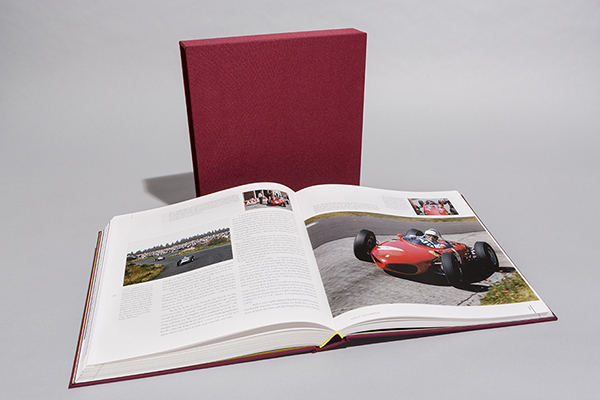
Based upon many hours of conversations taped exclusively for ‘Inside Track’, together with other material accumulated over many years of friendship with John Lamm, Doug Nye and others, The Racing Autobiography tells the story of Phil Hill’s life in his own words, from his childhood in 1930s California through his later years as co-owner of the highly successful Hill & Vaughn car restoration business, a respected motor sport writer and TV commentator, and much loved elder statesman of the American vintage and classic car movement with an unrivaled knowledge, in particular, of the Packard marque and its cars.
Illustrated by numerous photographs, letters, race posters and programmes, and other automobilia from the Hill Family archive, plus many other photographs of Phil’s racing career and beyond – including his last great victory in the charismatic Chaparral 2F at Brands Hatch in 1967 – the book offers an unrivaled view of this remarkable man.
The Racing Autobiography is hardbound with a cloth-covered case and inset photographs to match the two volumes of the Collector’s Edition, with the same page size and 428 pages, and is presented in its own cloth-covered slipcase.

Graham Robson is the doyen of writers on rallying. His new book, Works Healeys in Detail, joins his respected Works Triumphs and Works Escorts in our list. Here he tells of the story of Donald Healey’s introduction of the cars of his own make into the world of rallying and racing, from the Healey Elliott and Westland of the late 1940s through to the last racing Austin-Healey Sprite in 1967. In between he produced competition versions of the Austin-Healey 100 and 100S, the 100-6 and the gloriously successful 3000, a brutal and wayward machine that won countless international rallies in the 1960s in the hands of great drivers like Pat Moss, Timo Makinen, Rauno Aaltonen and Paddy Hopkirk, to name but a few.
The book covers the career of each of the works cars individually: entries, drivers and results, with nearly all cars illustrated. In addition there is detailed colour photography of important surviving examples.

Factory-correct cars will always be the most valuable cars on the market. Original Chevrolet Camaro 1967-1969 tells you exactly which parts, accessories, finishes, fabrics, and colors you must have to restore your Camaro to its factory-original condition—or exactly what to look for when shopping for a restored Camaro.
Some 250 color images detail Chevy’s major performance packages of the period—the SS, RS and Z/28—while exhaustively detailing engines, interiors, and bodies. Of equal importance, muscle-car authority Jason Scott provides factory records, comprehensive specifications, detailed parts lists and codes, and period literature to offer the definitive guide to originality.
Chevrolet’s Camaro was introduced in 1967 on the heels of Ford’s best-selling Mustang. It quickly established itself as the go-to option for muscle-car customers wanting a more aggressive pony car.
During its first generation from 1967 to 1969, GM offered option packages to satisfy all tastes, from six-cylinders grocery-getters to agile small-block cars to big-block monsters ready for drag racing straight off the showroom floor. Today, these first-generation Camaros are some of the most valuable cars in the collectible muscle-car market.
This is a must-have volume for any enthusiast shopping for a first-generation Camaro or about to undertake a restoration project.

This book focuses exclusively on the development of the Tipo 33 and the motorsport activities of the car during 1967.
It was a long held belief that there was only scarce documentation available concerning Autodelta, the motorsport company. With the help of Dr. Marco Fazio we were able to unearth various diverse records from the Alfa Romeo archives which contained detailed reports of the race activities of Autodelta. With such records to hand we were able to build an complete picture, free of any doubt, of the cars that participated in races during 1967 in the works team.
In addition to the racing participation of the Tipo 33 we have also covered aspects of the Tipo 33 Stradale and the related Alfa Romeo OSI Scarabeo.
Work on a second book covering the 1968 racing season is currently under way and is planned for release in 2019.
312 pages, 224 black and white photographs and 114 colour photographs
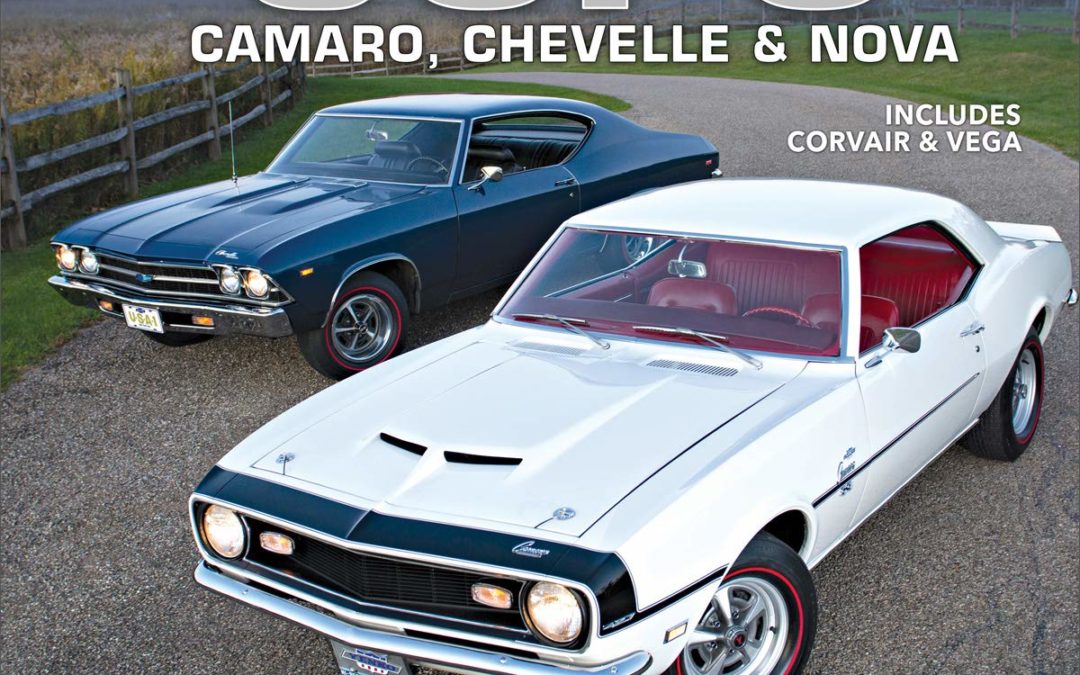
The COPO Camaros, Chevelles, and Novas of the 1960s and early 1970s were the ultimate high-performance GM muscle cars. While few knew about this back channel program at the time, it is now recognized as the origin of GM’s top muscle cars. Dedicated Chevy racers and car owners were determined to compete head-to-head with Mopar and Ford at the racetrack and on the street. But in order to do so, they needed to circumvent the corporate ban on racing and resolve the restriction of 400-ci engines in intermediate vehicles. Don Yenko and some other creative individuals recognized the loophole in the COPO (Central Office Production Order) system at General Motors. The COPO program was designated for fleet vehicles such as taxicabs, but at the peak of the muscle car wars it was used to build the ultimate high-performance Chevy muscle cars.
Some horrific on-track accidents compelled General Motors to drop out of racing, yet GM did not want to allow Chrysler and Ford to steal the glory on Sundays while they stood on the sidelines. As a result, GM inconspicuously ran the Chevy racing and high-performance program through back channels, and COPO was integral part of the program.
Don Yenko became the COPO muscle car program chief architect and champion. He ordered the Corvair through the COPO program and created the Corvair Stinger to mount a SCCA road race campaign. From these humble beginnings, the road map for creating the ultimate Camaros, Chevelles, and Novas was established. Factory Camaro V-8s came equipped with the 350 small-block or 396 big-block, which had to compete with the Mustang Cobra Jets and Mopar Wedge and Hemi cars. In response, building the big-block Camaro through the COPO program was devised. At the factory, Camaros were fitted with the 396 engines and shipped to dealers where the 427s were installed in the cars. From 1967 to 1969, the factory and dealers installed eight different 427 engines, including the all aluminum ZL1 427. Later on, others used the road map to build COPO Novas and Chevelles to similar spec, with similar results. The COPO performance car program did not end with these muscle cars. Yenko even ordered several hundred Vegas through the COPO program, so they could be fitted with turbochargers and raced in SCCA competition.
Chevy muscle car aficionado and author Matt Avery retraces the history of the COPO program and the creation of these premier muscle cars. He has scoured archives and tracked down owners and personnel involved in the program to deliver a comprehensive story and complete guide to the COPO cars. The COPO muscle car and racing program produced a storied and remarkable journey, and author Matt Avery captures all these facets in this entertaining and revealing history.

Alfa Romeo’s World Championship-winning sports car, the Tipo 33, enjoyed a long career; as a factory car, as well as in private hands from 1967 until 1977. The great Italian motor sport engineer Carlo Chiti designed and ran a prolific number of different models of this Tipo.
Unfortunately, nothing of the history of these developments was documented at the time. That is where authors Peter Collins and Ed McDonough come in. After an intense investigation and numerous personal interviews, to uncover much about this marvelous sports prototype, they are able to present Alfa Romeo Tipo 33.
The fruits of their labors abound, manifesting as many previously unseen photographs and the personal recollections of the prime movers in the Tipo 33’s career. If you like Alfas, you’ll love this book.
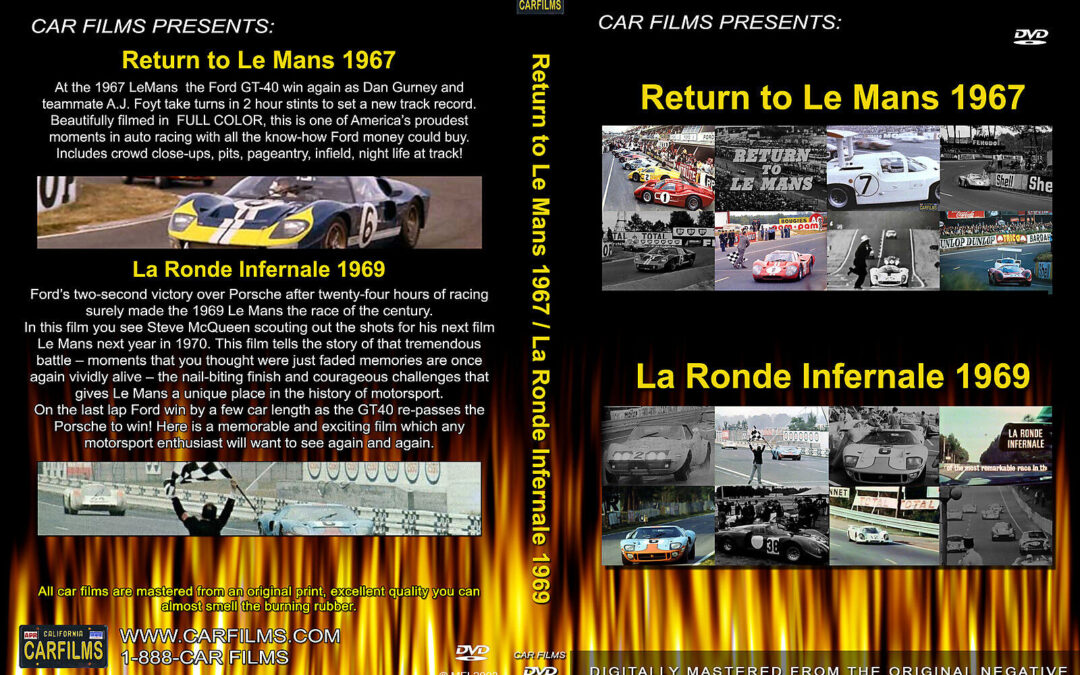
RETURN TO LE MANS 1967
At the 1967 Le Mans the Ford GT-40 wins again as Dan Gurney and teammate A.J. Foyt take turns in 2 hour stints to set a new track record.Beautifully filmed in full color, this is one of America’s proudest moments in auto racing with all the know-how Ford money could buy.
Includes crowd close-ups, pits, pageantry, infield and night life at the track.
LA RONDE INFERNAL 1969
Ford’s two second victory over Porsche after twenty four hours of racing surely made the 1969 Le Mans the race of the century.
In this film you see Steve McQueen scouting out the shots for his next film, Le Mans the next year in 1970.
This film tells the story of that tremendous battle – moments that you thought were just faded memories are once again vividly alive – the nail biting finish and courageous challenges that give Le Mans a unique place in the history of motorsport.
On the last lap Ford wins by a few car lengths as the GT-40 re-passes the Porsche to win! Here is a memorable and exciting film which any motorsport enthusiast will want to see again and again.
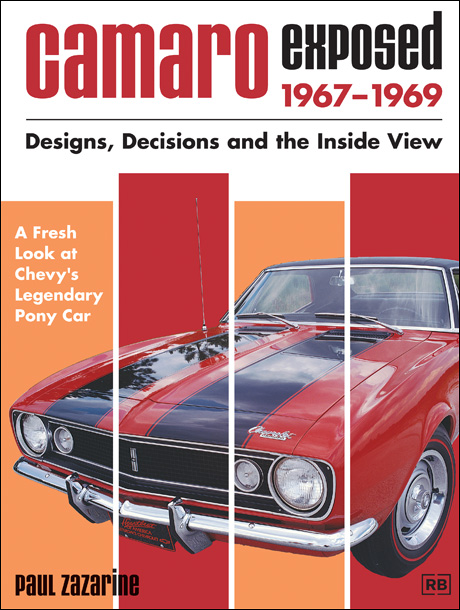
A Fresh Look at Chevy’s Legendary Pony Car
Camaro Exposed, 1967-1969: Designs, Decisions and the Inside View tells the story of the formative and most collectible years of that classic pony car. Paul Zazarine, the noted muscle car enthusiast and expert, documents the rise of the Camaro from the first glimmer in Chevrolet’s eye to the mighty COPO 427 Camaro.
Camaro Exposed documents through first-hand reminisces of GM engineers and previously unpublished photos the development of GM’s high-performance muscle car. For the first time, the reader will be able to view the proposed Camaro station wagon, Camaro fastback, and other amazing designs that GM had seriously considered as it waged a sales war with Ford’s highly successful Mustang.
Camaro performance enthusiasts will find special delight in the chapter devoted to one of the greatest muscle cars: the Z/28. Learn how the car was first conceived, the various stages of its development, and how Ford battled back in the showroom and on the track with the Boss 302. Zazarine details both the manufacturing development of the Z/28 and the road racing warfare that went on between the Chevrolet supported Penske/Donohue Trans Am team and Ford�s appointed road warriors.
To top off the story, Zazarine includes a chapter on the ultimate Camaro: the COPO 427. Remember the days of Yenko, Nickey, Baldwin-Motion, and Dana Chevrolet – those “little old Chevy dealers” with the monster Camaro options? Camaro Exposed reproduces the original ads dealers used to promote these ultra-potent Camaros and their drag racing conquests.
Camaro Exposed, 1967-1969: Designs, Decisions and the Inside View is mandatory for muscle car and Camaro lovers. With first-hand interviews and unpublished photos, this book is a great research tool and a terrific gift.
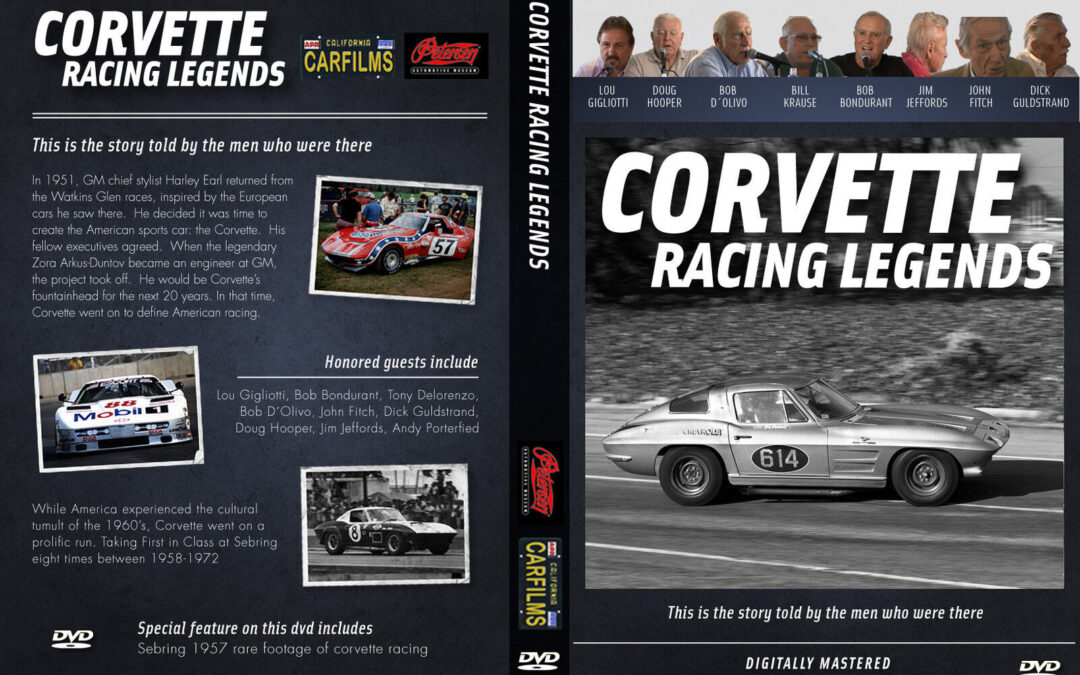
Hosted by Tim Considine at the Petersen museum
In 1951, GM chief stylist Harley Earl returned from the Watkins Glen races, inspired by the European cars he saw there. He decided it was time to create the American sports car: the Corvette. His fellow executives agreed. When the legendary Zora Arkus-Duntov became an engineer at GM, the project took off. He would be Corvette’s fountainhead for the next 20 years. In that time, Corvette went on to define American racing.
Just three years after the prototype was approved, driver John Fitch set a production-car record of 145 mph at Daytona Speed Week. That same month, Zora Arkus-Duntov set a record-breaking average of 150.583 mph at Daytona Beach. This was in 1956! But Earl and Duntov knew that a true American sports car required an ideal combination of world-blurring speed and unyielding stamina. Starting with a First in Class finish at the 1956 Grand Prix of Endurance in Sebring and an SCCA National Title at the Seattle Seafair, Corvette entered racing lore.
While America experienced the cultural tumult of the 1960’s, Corvette went on a prolific run. Taking First in Class at Sebring eight times between 1958-1972, they also won the same honors in ’62, ’66, ’68, ’70, and ’72 at the Prestigious Daytona Continental. Additionally, Corvette debuted at, and won, the 1962 Invitational Grand Prix in Riverside. The next year Corvette was the overall winner of the 1963 Watkins Glen International.
The Corvette engineered other impressive feats, such as reaching 183 mph on the GM Proving Grounds—in 1958! The 1963 Watkins Glen championship was won by a Grand Sport Corvette just one year after the model’s initial production. And in 1979, at Bonneville Speed Week, a 1968 Corvette set a GT record of 210.762 mph—making it the fastest carbureted car in the world.
Over the years, Corvettes have been piloted by a host of ace drivers. In 1959, Jim Jeffords and his “Purple People Eater MK III” shredded all comers and won the SCCA championship. And most notable of all has to be Roger Penske, who was the wheelman primarily responsible for the team’s ‘60s dynasty. But it was Briggs Cunningham who may have had the most important impact because, in 1960, he was the first driver to enter his Corvettes into the ultimate challenge of auto-racing: the 24 Hours of Le Mans.
Cunningham’s respectable 5th in the GT category and 8th overall laid the groundwork for Corvette’s future success– successes that include Dick Guldstrand’s then-record speed of 171.5 mph on the Mulsanne straight in 1967. Those triumphs continue to this day. Corvettes won the GT class at Le Mans in 2001, ’02, ’04, ’05 and ’06. Which brings Corvette’s story full-circle. Inspired by the powerful European marks as seen at an American race in the ‘50s, the team accepted the challenge of creating an American supercar to compete with those monsters, and a half-century later they have their golden child, which they win with—in the heart of Europe itself—on the world’s largest international stage.
Earl and Arkus-Dontov would be proud.
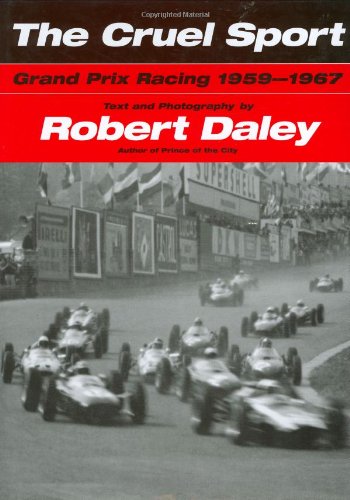
SOLD OUT
It was an era of daring, dashing drivers piloting incredibly powerful race cars around fast and legendary circuits with only primitive safety equipment to spare them disaster. The book includes sections covering the drivers, cars, factories, practice sessions, race day races and, inevitably, accidents. The text is incredibly compelling, as would be expected from a world-class writer. The design and photo presentation remain true to the original edition, published in 1963, and are supplemented by a new introduction and epilogue and revised captions. A rare period piece certain to delight racing fans.
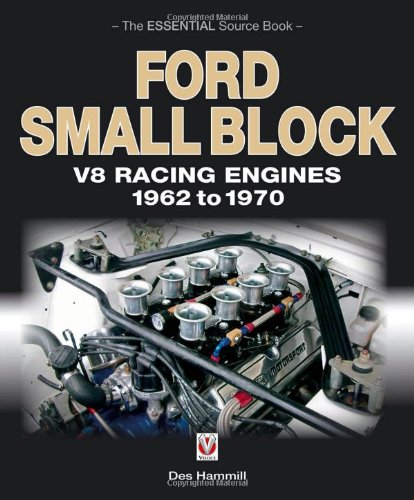
This is the story of the Ford small block Fairlane V8 engine’s rapid evolution from passenger car engine to highly successful racing engine and the victories it fueled for years afterwards. Initially, in May 1960, a team of nine engineers, lead by George Stirrat, designed a lightweight, all cast-iron, compact, reliable and durable power-plant for passenger cars, but following its introduction in July 1961, Ford’s engineers quickly realized its potential benefits if modified for racing applications. Within three months, the capacity had been increased from 221ci to 260ci, and by early 1962 Carroll Shelby had fitted a High Performance 260ci version in his AC Cobra. Subsequently, the original design team began work on a second capacity increase, to achieve a High Performance 289ci unit; within three months the standard 289ci became available. Carroll Shelby went on to win the 1965 World Sports Car Championship using a HP-289ci. Aluminium block and cylinder head pushrod versions, designed in late 1962, had been constructed by early 1963, in preparation for that year’s Indianapolis 500, and the DOHC four-valve per cylinder 255ci raced in the 1964 and 1965 Indy 500, winning the latter outright. The 302ci replaced the 289ci for the 1968 car model year and, at Le Mans in 1968 and 1969, GT40 cars won outright using this variant of the small block. In 1965, 1966 and 1967, HP-289ci-powered Mustangs won the SCCA B-Production Championship and 1966 and 1967 Trans-Am Championships. A Bud Moore Engineering Boss 302 Mustang won the 1970 Trans-Am Championship. Ford invested much time and expertise into its racing activities in the 1960s, and there’s little doubt that the V8 Small Block engines took the company to the forefront of the racing world, until it withdrew from the sport in 1970.
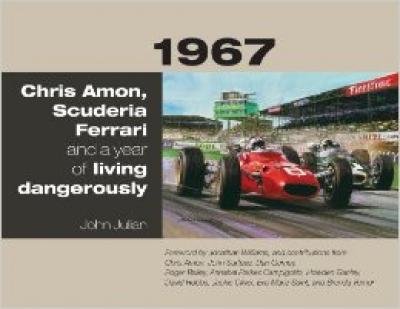
“1967 was a milestone year in motor racing. For Ferrari, the season started with sports-car victories at Daytona and Monza, but soon turned tragic with the death of Lorenzo Bandini after an accident at the Monaco Grand Prix. At Spa, another spectacular accident put Mike Parkes out of action with two broken legs, and prompted Ludovico Scarfiotti to quit the Ferrari team. That left Chris Amon, a 23- year old New Zealander in his first year with the Italian team, to fight on alone until the year’s last race in Mexico. He would finished fourth in the F1 Drivers Championship after reaching the podium four times.
While Amon and Ferrari take center stage, 1967 also looks at the other drivers, teams, and events that shaped the campaign for the championship. The book includes observations and memories from such leading drivers as John Surtees and Dan Gurney, as well as informed insiders like Amon’s countryman Howden Ganley, Enzo Ferrari’s assistant Brenda Vernor, and Grand Prix star Eva Marie Saint. It also goes beyond Amon’s time with Ferrari, covering both his early years with the Cooper and Parnell teams, his 1966 victory at Le Mans with Bruce McLaren, and his later career with March and Matra.
Amon worked closely with author John Julian to explain exactly what it was like to compete at the highest level during a unique moment in motorsports history, and his first-hand recollections give the book a very personal quality. Julian’s vibrant prose and extended quotes from key characters make 1967 a fast-paced read, with a wealth of photographs adding atmosphere and excitement. And while the book includes enough detail to satisfy the most serious fan, it also offers a wider view of a bygone era by noting other events in the news, popular songs of the day, and local details about each major race.
”
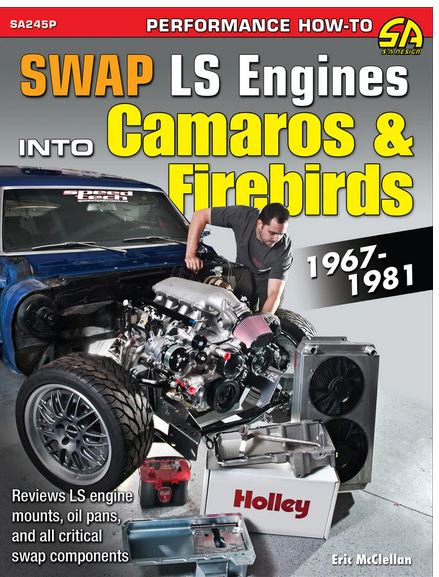
The 1967-1981 Camaros and Firebirds are enduring classics that include the Z28, Firebird Formula 400, and the Smokey and the Bandit edition Trans Ams. But many owners want their rides to have the latest and greatest in GM engine technology and performance, and that’s the LS engine. These F-Body cars readily accept these compact, lightweight modern V-8 engines. The LS engines produce more horsepower per cubic inch than almost all other pushrod V-8 engines, so the combination of the LS engine and a Camaro or Firebird make for an extraordinary performance car. And that’s precisely why these engine swaps have become so popular.
To perform a professional caliber LS engine swap into a Camaro or Firebird, you need proper planning, the right combination of parts, and information to complete the project. Swap LS Engines into Camaros & Firebirds: 1967-1981 provides excellent instruction and guidance for selecting the best engine for a budget, choosing the adapter plates and engine mounts, dropping the engine into the car, selecting the ideal transmission and drivelines, and completing all facets of the swap. You need to ensure that all the other components on the car are compatible with the engine, so author McClellan instructs readers how to integrate the electronic engine control system on the early F-Body cars as well as select and install exhaust, intake, fuel pumps, and upgrade cooling system for the high-performance LS.
While the swapping process is covered in detail, the author also provides a helpful Gen III and Gen IV LS engine guide, so the reader finds the best performing and reliable engine suited for a particular car and application, such as Pro Touring, drag racing, and high-performance street. In addition, the author explains how to shop for and buy a used LS engine from a salvage yard, so you get a good engine with all required accessories. When you are ready to swap a stock powerplant engine for a GM LS, you are going to need this book.
The photos in this edition are back & white.
